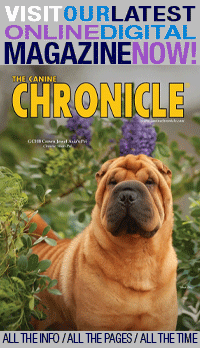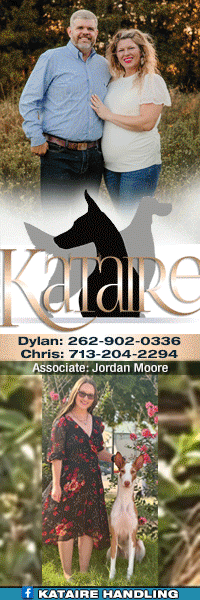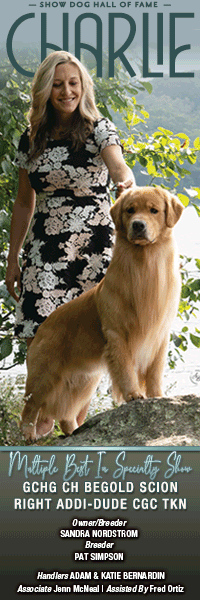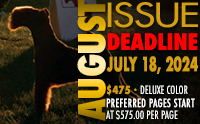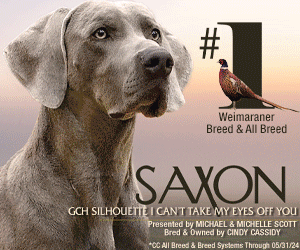Reason to Breed
Click here to read the complete article
Improvement, Preservation or Both?
by Peri Norman
 When I started in dogs, I was taught that “improving the breed” was a primary reason for breeding. The goal was to always see improvements in the pups on both parents. Improvement is defined as:
When I started in dogs, I was taught that “improving the breed” was a primary reason for breeding. The goal was to always see improvements in the pups on both parents. Improvement is defined as:
• the act of improving something: the act or process of making something better
• the quality of being better than before
• an addition or change that makes something better or more valuable
Turns out that defining improvement in individual dogs, let alone an entire breed, can be a tricky process. Deeply committed and passionate breeders have very different ideas about the qualities that define a breed and, consequently, what constitutes an improvement or, for that matter, deterioration.
In her book Born to Win: Breed to Succeed, Patricia Craige (Trotter) states, “Type is what differentiates one breed from another. It is the collection of all the characteristics and traits that make a given breed different from others. It is apparent in the contour, make and shape of the animal. It is the essence of the breed in looks and behavior, in ability and in function.” She goes on to say, “A case could be made that in judging the dog what contributes to the dog doing its job is a virtue; what interferes with the dog doing its job is a fault.”
Many years ago my sister had a friend who had Brittanys. Her friend had purchased a promising young male of dual potential. Her friend had some experience in bird work and felt comfortable training and handling the dog herself in field trials, but asked my sister to handle him in the breed ring. My sister finished the dog quickly and he went on to fulfill his potential as a quality Dual Champion dog.
A few years later, my sister handled another Brittany for her friend. It was a daughter of the lovely dual champion. She was a bit harder to finish, but it got done and her fieldwork was spectacular. Within another generation, finishing bench championships was getting progressively more difficult and not surprisingly, the focus became exclusively fieldwork; the area where the dogs were most competitive and where the owner got more enjoyment from their accomplishments. I remember at the time telling my sister that her friend’s dogs were not Brittanys anymore. They were just generic red and white bird dogs. That was harsh and I was mistaken!
Breed preservation is a relatively new concept in the history of animal breeding. Conservation of plant and animal populations began directed primarily at wild species. Yet, in our increasingly urbanized world, we continue to lose contact with our connection to nature and our appreciation of its importance. The Livestock Conservancy offers the following thoughts on conserving rare breeds of livestock. “These rare breeds are part of our national heritage and represent a unique piece of the earth’s biodiversity. The loss of these breeds would impoverish agriculture and diminish the human spirit. We have inherited a rich variety of livestock breeds. For the sake of future generations, we must work together to safeguard these treasures.”
Colonial Williamsburg Coach and Livestock Department Staff share this orientation. “These animals are more than just a museum display or a history lesson on how agriculture has changed over time. They are essentially a safety deposit box for the future and a legacy left to us by many generations of farmers that came before us. The agriculture system in the modern industrialized world, in which only 2 of every 100 people actually farm, was developed because of the diversity of plants and animals from which farmers had to choose. As farming changes, and as new problems and diseases appear, we need diversity more than ever.”
Preservation can be defined as:
• the act or activity of keeping something in an existing and usually satisfactory condition
• the careful maintaining and protection of something valuable especially in its natural or original state
Given the shrinking number of purebred dogs in our society and the threats to the continuance of deliberate, thoughtful dog breeding, it is not a stretch for us to redefine ourselves, not simply as dog breeders, but as breed preservationists. It is a new and interesting suit of clothes that we begin to try on for size and comfort as we contemplate our role as dog breeders stretching beyond a hobby that is incomprehensible to many (whether it is conformation showing, bird hunting, stock work or sledding), and expand it into a role involving a more significant contribution to society as a whole and an effort to conserve that which is being lost.
This may cause some cognitive dissonance for many thoughtful people as we re-evaluate our goals and objectives. One thing that is required by our role as preservationists and by our current political climate is a very careful definition of improvement. In her book Bred for Perfection; Shorthorn Cattle, Collies and Arabian Horses Since 1800, Margaret E Derry poses the following question, “Collie breeding also demonstrated that breeding purely for fancy points made defining improvement more difficult, because fundamentals relating to original or authentic type were threatened by open disregard for utility. The deep-seated perception that breeding for fancy undermined the general utility of the dogs created a dichotomy: Could show Collies be described as “improved”?”
Craige also discusses at length the trend toward ‘if some is good, more must be better’. She says, “The cumulative effect is that the once functional animal has been taken to such extremes in type that it becomes a caricature of what it was.”
Yet, preservation of the original form of functionality clearly is not an option in the real world for many breeds. Rhodesian Ridgebacks no longer hunt lions. So-called “blood sports” are not acceptable in today’s world, and the breeds of dogs that participated in those sports require, at minimum, a major overhaul in temperament. Dachshunds no longer hunt badger and, in fact, many owners and breeders of sporting dogs couldn’t care less about their dog’s ability to flush, point or retrieve game. In the eyes of most, these are obsolete yardsticks which have no relevance to today’s world.
So here is a startling idea! It is all good! You can be a breed preservationist and breed for beautiful dogs. You can be a breed preservationist and breed great working dogs. You can breed dogs that are terrific at companion events like tracking, obedience, rally or agility. You can breed dogs that make good pets, because at the end of the day, nothing in our relationship with our dogs supersedes their ability to make us smile, to cuddle with us when we are not feeling well, and to remind us that the world is still good even after a tough day at work. We need all the genetic diversity that we can get. Regardless of how big, important and frustrating our differences of opinions with other breeders are, if we are going to maximize our role in not only the preservation of our breeds, but our enduring relationship with dogs as a part of our families, we must view ourselves and others in our breed as a part of the same team.
There are, of course, two caveats and they are what define us as responsible protectors of our breeds. The first is awareness and conscious avoidance of genetic disease. These are disease processes that we did not “cause”. They have been present in the gene pools of various breeds since the beginning and also exist in crossbred and mixed breed animals. We know that all dogs are not going to be perfectly healthy. Like humans, livestock and every other living thing, dogs will get sick because it is part of life. Our mission that we must pursue along with preserving our breed and its unique and valuable characteristics includes a serious effort to minimize debilitating disease. Dr. Carmen Battaglia puts it this way, “Genetic disorders occur in humans and canines throughout the world and contrary to popular belief, no breed has been spared from problems. There is little doubt that health issues are among the top concerns of all owners and breeders. But not all health problems are the same; some are worse than others. At the top of the list are those called the dreaded diseases. These are the disorders that can cripple, kill, cause early death or blindness.”
Truly committed breeders have a laundry list of disorders that they work to avoid. The list is prioritized with the most onerous conditions at the top and things that one would “prefer not to have, but can deal with” on the bottom. The lists are absolutely breed-specific and they may change over time. For many years now, idiopathic epilepsy has been at the top of my list. In the past couple of years, BOOM — epilepsy has been replaced by gastric carcinoma. While there is nothing more distressing than watching your beloved companion have a grand mal seizure, it does pass fairly quickly and in my experience, it is generally treatable. Gastric carcinoma has added a whole new level to my worry-ometer. One day they vomit; three weeks later, they are dead. Gastric carcinoma is particularly devastating as it is normally diagnosed in middle-aged dogs; some as young as six years old. It is a universally fatal disease that significantly shortens an individual’s expected lifespan. On the other hand, missing teeth and undescended testicles are clearly areas of concern, but dogs with these conditions can live a perfectly healthy, happy life as a pet or competitor in multiple venues.
The second caveat is a bit trickier. We have acknowledged that some breeds of dogs must be changed significantly from their original purpose if we are to retain those characteristics that are valuable and useful to us. Repurposing, remodeling, yes, even “improving” a breed is an undertaking that requires serious contemplation regarding the elements of that breed that we are removing and the merit of the qualities we are adding. There is no question that in our society aesthetics are of tremendous importance. Particular color patterns, eye color and abundant coats may or may not affect a dog’s working functionality, but often do contribute tremendously to our enjoyment and sense of beauty that we associate with our breeds. So here is the catch. That which we have come to value as an essential component of any breed (repurposed or theoretically functional) must not be detrimental to the dog’s health and well-being. These are “genetic” problems that we have caused, perpetuated or exacerbated by our desire for more extreme characteristics; smaller eyes, shorter muzzles, longer backs and more sloping toplines are a few examples.
I am certain no one has forgotten the tidal wave of outrage that followed the airing of the powerful BBC documentary, Pedigree Dogs Exposed, in August of 2008. While we all hate the negative attention created by situations like this, we have to recognize that our world has changed and, deserved or not, many people have a very negative view of purebred dog breeders. We need to spend some time in honest thought and examine what we do because of our breed culture that may not appear so acceptable by someone outside our world, and eliminate, or at least mitigate, things that really are not in the dog’s best interest.
I was judging collies one beautiful morning and the sun had just broken through the overcast. I walked up to a beautiful, sweet young bitch and imagined that she was relaxing in the warmth of the just-arrived sunshine with a smile on her face and her eyes almost completely closed. I waited for a moment for her to open her eyes and acknowledge me because I didn’t want to startle her or interrupt her peaceful interlude. Then I realized that her eyes were open. None of our breeds of dogs are perfect. They all have tendencies toward some genetic disease and/or temperament quirks. But we absolutely must begin a candid conversation about “desirable” traits that simply are not good for the dogs – microphthalmia is one of them. Achondroplastic dogs and brachycepahlic dogs have their own sets of problems. Breeders need to be honest and excruciatingly careful not to further exaggerate these conditions. Puppy buyers must be fully informed about the inherent risks and how best to manage these dogs to minimize a potentially traumatic situation.
The concept of purebred dog breeders as breed preservationists is an intriguing one. Improvement and preservation are not mutually exclusive goals. We can do both when we are mindful, and practice our dog breeding with the utmost of personal integrity and candor. We must recognize the hard realities of our current situation and adjust our thought processes accordingly or in a short time we shall have nothing left to preserve.
Short URL: https://caninechronicle.com/?p=87805
Comments are closed
